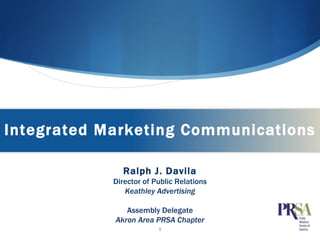Integrated Marketing Comm Presentation (1132009)
- 1. Integrated Marketing Communications Ralph J. Davila Director of Public Relations Keathley Advertising Assembly Delegate Akron Area PRSA Chapter
- 2. What is IMC? A management concept that is designed to make all aspects of marketing communication such as advertising, sales promotion, public relations, and direct marketing work together as a unified force, rather than permitting each to work in isolation . Source: Laura Lake, About.com
- 3. What is IMC? Integrated Marketing Communications The ŌĆ£NewŌĆØ Advertising Agency Team centric/Holistic approach Started in the early 1990s by David Ogilvy Shift away from just being ŌĆ£creativeŌĆØ and developed to create heightened ŌĆ£brand awarenessŌĆØ
- 4. PRŌĆÖs Role in IMC At its core, IMC is: Strategic Focused Communications Concise, holistic, strategic communications across all disciplines No one is better to lead this than PR professionals
- 5. IMCŌĆÖs Objective Create an authentic experience that allows customers to identify with the brand on rational and emotional levels across all communications platforms Used with permission from Brett Turner, APR, of Jackson Marketing Group Emotional ŌĆ£ Our beliefs are the sameŌĆØ Loyalty ŌĆ£ I love the brandŌĆØ Preference ŌĆ£ I prefer the brandŌĆØ Awareness ŌĆ£ I am aware of the brandŌĆØ
- 6. Elements of IMC Courtesy of Jackson Marketing Group
- 7. IMC 10-Step Process 1. Get commitment from senior management 2. Build your team of experts (Interactive, PR, media, etc.) 3. Have someone leading the charge 4. Plan (strategy, objectives, key messages, etc.) 5. Start integrating; Get buy-in from everyone 6. Let your teammates do their job and trust them! 7. Share information across disciplines (Update meetings) 8. Be flexible and listen to your team 9. Adapt and improve 10. Show off ŌĆō Metrics; praise team; savings
- 8. IMC Case Study GE Project Plant-A-Bulb
- 9. Campaign Components Public Relations Media Planning & Buying Interactive Media Grassroots Initiatives Direct Marketing Social Media
- 10. Q&A Thank You
Editor's Notes
- #4: *** Instead of just working on being fun and creative without purpose, but instead tried to have the objective in mind with a measureable goal. *** Not to hope that just because something is creative and wins awards it will affect and motivate purchase or awareness among the target audience.










